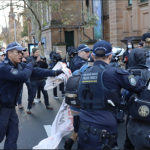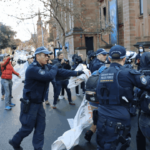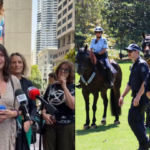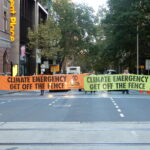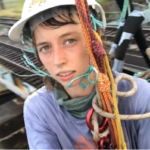Under the NSW Antiprotest Regime, Oppressive Bail Conditions Are the True Punishment
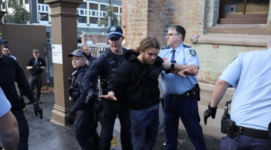
After having been charged under the then recently enacted NSW antiprotest regime last June, ten Blockade Australia activists appeared before NSW Magistrate Christine Haskett at Sydney’s Downing Centre Local Court on 5 April.
The extreme antiprotest regime was a Perrottet government response to a series of direct actions staged by climate defence groups, which were nonviolent in nature, yet served to disrupt business as usual in an effort to raise public awareness to the escalating climate crisis.
The unprecedented laws included an amended section 144G of the Roads Act 1993 (NSW) that covers the unapproved disruption of roads, bridges and tunnels, as well as new section 214A of the Crimes Act 1900 (NSW), which created the offence of obstructing major facilities via protest.
And both these laws caused jaws to drop as they incur maximum penalties of up to 2 years inside and/or a fine of $22,000.
However, about a month prior to their appearances, the prosecution dropped the section 144G charges against the activists as part of a plea deal, and they were replaced with the regular lesser offence that was triggered prior to the Liberal Nationals’ overbearing crackdown on climate dissent.
And while Blockade has since pointed to the dropping of the section 144G charges, as signalling that the offence may not hold up in court, the group has also reinforced another of its assertions, which posits that state authorities are knowingly using bail restrictions to inflict the real punishment.
An untenable regime
“The withdrawal of the section 144G charge is an apparent admission by police prosecutors that this charge is unlikely to win in court,” said Blockade Australia in a 5 April statement.
“The anti-protest laws have themselves been the subject of protest, with over 240 unions, civil rights and environment groups calling them an attack on democratic freedoms, and challenging the constitutionality of the laws,” the statement continued.
Blockade disrupted Sydney’s Port Botany over five days in late March 2022, while, that month also saw Fireproof Australia obstructing roads across the city. And due to their disruptive nature, these actions were capturing public attention, and in turn, spreading awareness of the climate crisis.
So, Coalition ministers and AM radio shockjocks had a field day raising community fears over a suggested scenario whereby an ambulance could be blocked by such an action, and hence, the life of an awaiting patient could be threatened, which provided a reason to enact these harsh new laws.
And after having pleaded guilty for the lesser charge of obstructing traffic, contrary to section 6 of the Summary Offences Act 1988 (NSW), Magistrate Haskett last week only entered a conviction against four of the Blockade activists, while seven received fines of between $100 and $1,000.
The real punishment
The dropping of the section 144G offence against the Blockade defendants, as well as the subsequent reduction in penalties on appeal against those who did go before the courts charged under section 144G, reveals that the real punishment is the imposition of oppressive bail conditions.
Such extreme bail conditions were first raised by climate defenders following the Spring 2019 Extinction Rebellion rally in Sydney. And the extent of the restrictions imposed upon the conditional release of those raising the climate alarm has been escalating ever since.
Blockade Australia has described these as the type of conditions “normally reserved for suspected terrorists”, and they’ve included bars on entering the Sydney CBD or even NSW, as well as bans on associating with long lists of people, restrictions on encryption use and daily reporting to police.
Following conviction on 5 April, activist Isabel Sleiman explained in a statement that they’d been arrested during the 27 June 2022 action, even though they were standing on the footpath when taken into custody and were then slapped with extreme bail on release 36 hours later.
“I was required to report to police twice a week and was not allowed to enter Sydney, my own city,” the 23-year-old climate defender said. “I was not allowed to have encrypted apps on my phone or to associate with 30 of my friends.”
Sleiman then related that they were rearrested in November, on suspicion of planning to attend a state-sanctioned protest. And at that time, officers discovered encrypted app WhatsApp on their phone, which saw them held for 24 hours and receive a further ban on the ability to leave NSW.
In this manner, whilst the harsh antiprotest penalties produced a chilling effect upon climate actions across this state, those who weren’t dissuaded by the new laws have since been hit by a wave of severe “bail controls”, which has served to wipe out any remaining unauthorised climate actions.
And these extreme bail controls are now being employed against activists mobilising over other causes.
UNSW SRC education officer Cherish Kuehlmann was hit with such conditions in February, after being arrested in relation to a housing crisis protest, while activist Stephen Langford received similar bail restrictions over a truth-telling demonstration he staged in March.
And along with climate activist Margaret Pestorius, Kuehlmann and Langford had their bail conditions dropped by the courts on challenging their validity, as it was found that police were using the restrictions to punish activists and stifle protests, rather than ensuring the progress of trials.
Silencing the need for reform
The former NSW Liberal Nationals government has just been replaced by a state Labor administration. However, new premier Chris Minns vowed to continue his predecessor’s antiprotest regime prior to being elected.
Indeed, both major parties in NSW rely heavily on the donations of the fossil fuel industry, as is the case in all Australian jurisdictions.
So, in many ways, these laws are to ensure further fossil fuel expansion at a time when climate-driven extreme weather events are fast becoming the norm.
A clear reason why police prosecutors might now be willing to forego the section 144G offence is that the state’s most well-known climate defender Violet Coco was initially sentenced to 15 months inside under them, which was then dropped on appeal, after widespread public outcry.
And those charged alongside Coco in relation to the April 2022 Sydney Harbour Bridge climate action have also had their punishments reduced, as their initial community correction orders (CCOs) were dropped to the lesser penalty of a community release order (CRO) on appeal.
But while the reduction in charges applying to the Blockade activists, and reduced punishment received by those involved in the Fireproof Australia Harbour Bridge action are welcomed, these outcomes have done nothing to deter the state in attempting to silence climate awareness.
“Experiencing this level of repression and surveillance for ten months, when all I did was join a street march, was so excessive,” Sleiman further underscored in her statement.
“I’m sure the disruption people experienced that day has been forgotten by now, but we are still being punished for trying to speak about the climate crisis. We are crying out for help. We want to be heard. Extreme weather events continue to harm us,” the activist concluded.
“Why is Australia shooting the messengers?”


